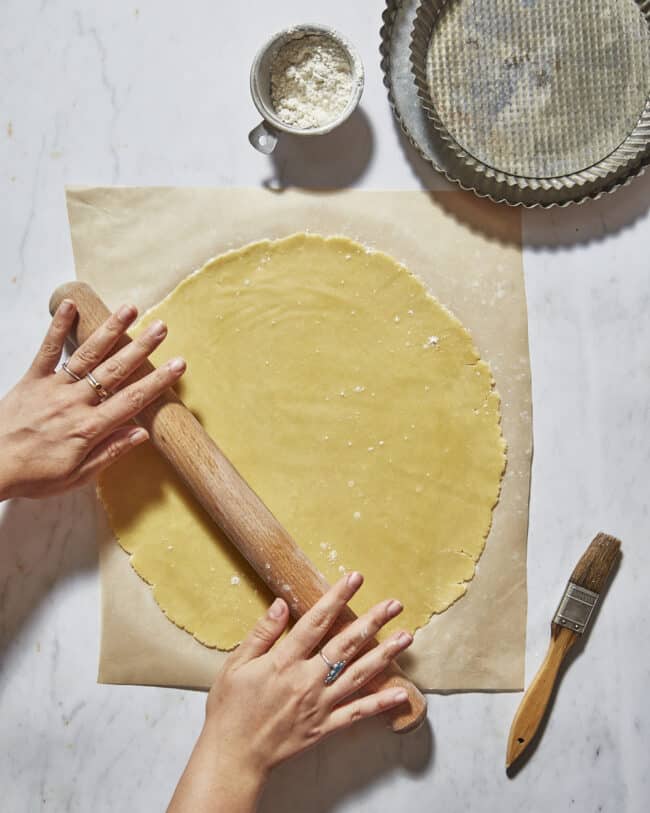
Shortcrust pastry is a useful recipe to know how to make. This pastry is used for lots of applications, especially savoury tarts like quiche. It’s a simple technique but there are a few pinch points to get right (such as keeping the ingredients cool and not overworking the pastry) which make all the difference between a light, crumbly pastry and a dense, tough one. In this post I’ve broken down as much of the science about pastry as possible (there’s a LOT of info in the section below the recipe card – use the table of contents above to get you to the right section). I’ve also put in a section on my top tips for the best shortcrust pastry.
So, now we know what ‘short’ means, it’s easy to see why this type of pastry is called shortcrust! Other things you can see a similar naming pattern in are shortbread, shortcakes and shortening (i.e. solid vegetable fat).
In French, shortcrust pastry is known as Pâte Briseé.
Tips & rules for making the best shortcrust pastry
- Keep your ingredients cold – having your ingredients (and environment + equipment, if possible) cold helps to keep the butter firm. This will keep the pastry at a workable texture and will prevent it becoming tough. If at any point the ingredients are getting too warm, put them into the freezer for 5 minutes to cool down.
- Work quickly – this is to ensure that the butter doesn’t spend too long at room temperature (which will warm it up). Again, this is to do with keeping everything cool so that the pastry is easy to work with and crumbly when baked.
- Don’t overmix – the key to great pastry is mixing/kneading it only *just* enough so that it comes together into a dough and no more than this! Excessive mixing/kneading will develop the gluten network in the dough, leading to tough pastry.
- Rest the dough – once the pastry has been mixed, it’s necessary to let it rest. This lets the gluten network to relax which should lead to less shrinkage of the pastry upon baking. We have to rest the pastry in the fridge, rather than at room temp, because the it contains butter which needs to be kept cold! If it’s not cold, it’ll soften/melt, creating a greasy, dense pastry.
- Don’t stretch the dough when lining the tin – try to ease the pastry into the tin rather than stretching it to get it into the nooks & crannies. If you stretch it now, it is more likely to shrink when baked.
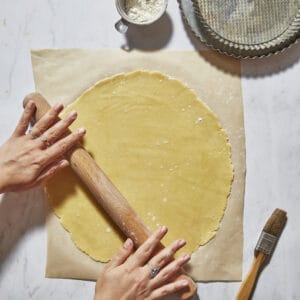
Shortcrust Pastry Recipe
Ingredients
- 200 g (1 ⅔ cups) plain white flour or pastry flour
- 100 g (7 tbsp) unsalted butter, cold, cubed
- 1/2 tsp fine table salt
- 1 egg OR 1 egg yolk (optional, see notes)
- 1 to 3 tbsp ice cold water
Instructions
- Place the flour into a large bowl along with the cubed butter and salt. Toss together to combine then use your fingertips to rub the butter into the flour until no large lumps of butter remain. The mixture should have a coarse, mealy texture (it should look a bit like ground almonds).200 g (1 ⅔ cups) plain white flour or pastry flour, 100 g (7 tbsp) unsalted butter, cold, cubed, 1/2 tsp fine table salt
- To check if the butter is fully incorporated, shake the bowl back and forth a few times which will force any larger clumps come to the surface which you can then rub in.
- If using the egg, add it to the bowl without any water. If you're using an egg yolk add it along with 1 tbsp of water to the bowl. If not using any egg, add 2 tbsp of water to the bowl.1 egg OR 1 egg yolk, 1 to 3 tbsp ice cold water
- Use a butter knife to 'cut' the wet ingredients into the dry – this helps to distribute the moisture around the bowl a bit.
- Test if it's wet enough: the mixture should clump together when a handful is squeezed together. If it seems too dry to clump together properly, drizzle in an extra 1 tbsp of cold water, 'cut' it through with a knife.
- Tip everything out onto a work surface and gently bring together by hand, squeezing it into a disk shape. You may have to knead it a couple of times to achieve this (try to mix as little as possible as overworking the mixture can lead to tough pastry). You should now have a smooth disk of dough.
If using the pastry now:
- Either place the disk of dough into a sandwich bag and seal it, or wrap the dough tightly in cling film.
- Chill the pastry in the fridge for 30 minutes until cool but still malleable in texture. If the chilled pastry seems quite firm, allow it to rest at room temp for 2-5 minutes until it's soft enough to roll, before using.
- Dust the disk of pastry lightly with flour before rolling it out to the desired size/thickness as designated by the recipe you need it for. I like to roll the pastry out on a large piece of baking paper as this stops it sticking to the counter. If at any point it seems the pastry is getting too warm, slide it onto a baking tray and chill for 10 minutes to cool it down.
If using the pastry later:
- Either place the disk of dough into a sandwich bag and seal it, or wrap the dough tightly in cling film.
- Chill the pastry either in the fridge for up to 3 days OR label & freeze it for up to 3 months.
- Remove the dough from the fridge/freezer and allow to come to room temperature before rolling it out as recommended by your recipe. For chilled pastry, this should take 30-60 minutes. For frozen pastry, this should take 2-3 hours.
Video

Notes
How to make shortcrust pastry – step by step images
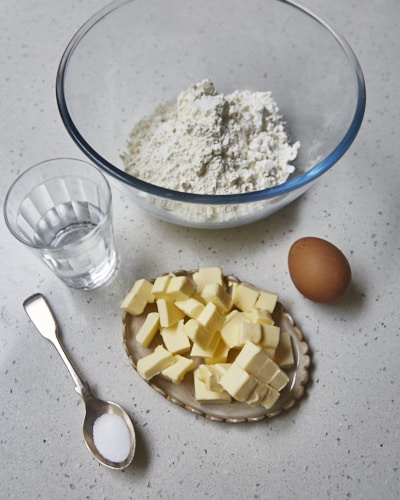
1. Cube your butter and gather your ingredients for the shortcrust pastry.
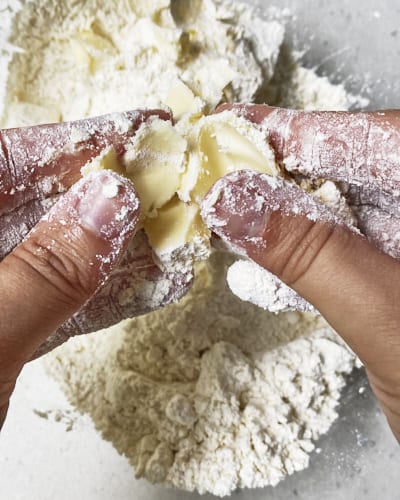
2. Add the cubed butter to the flour along with the salt. Toss together. Use your fingertips to rub the butter into the flour.
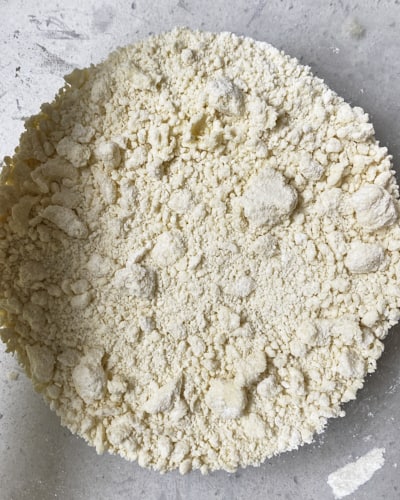
3. Shake the bowl back and forth to move any large lumps of butter to the surface then rub them in.
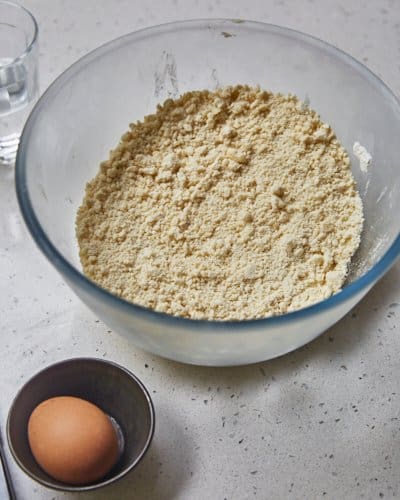
4. Once the butter is fully rubbed in, the mixture should look like breadcrumbs.
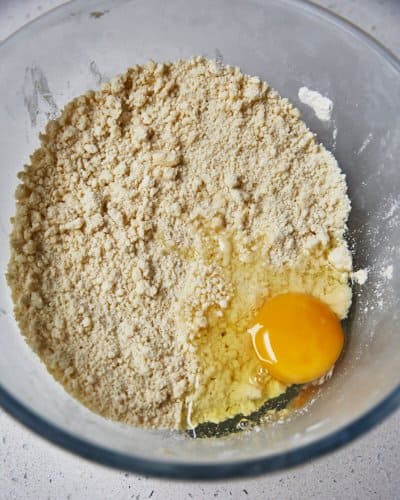
5. Add the egg (or water) to the bowl.
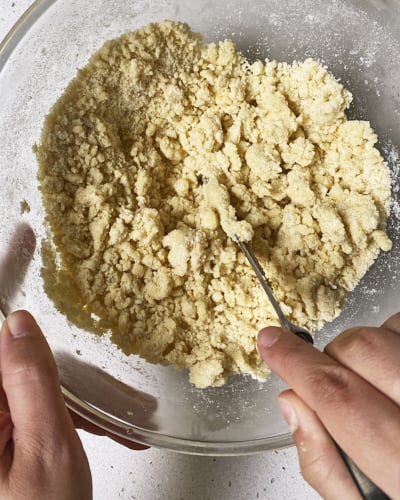
6. Use a butter knife to ‘cut’ the wet ingredients onto the dry.
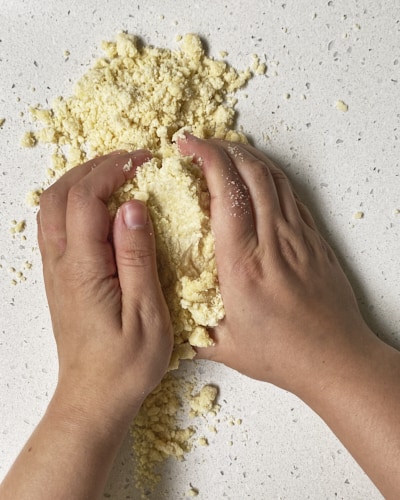
7. Tip the mixture out onto the work surface and bring together, kneading a few times gently.
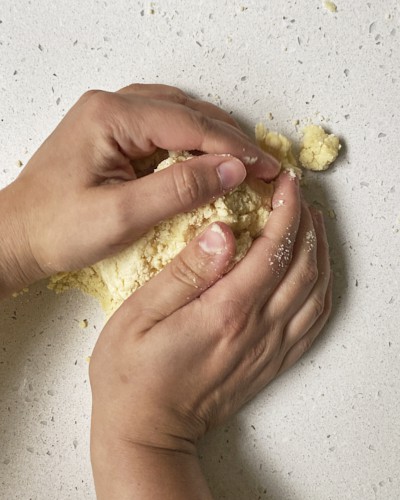
8. It will look crumbly at first but will come together to form a smooth dough.
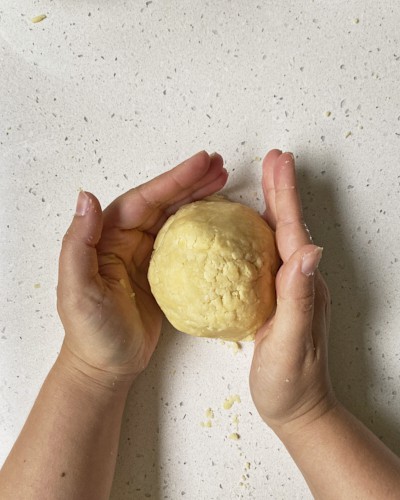
9. Form the pastry into a ball.
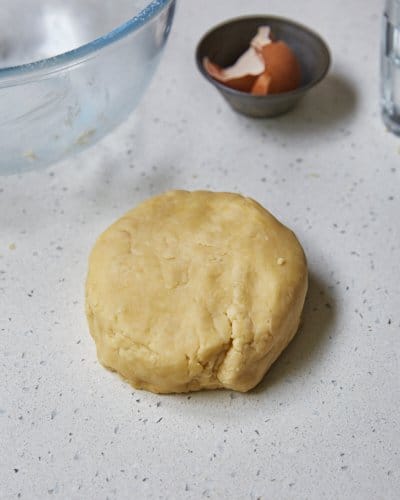
10. Pat the dough down into a disk.
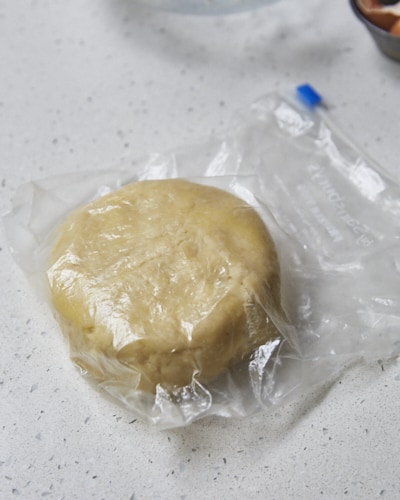
11. Wrap the dough in a resealable sandwich bag, pressing the air out (or wrap in clingfilm). Chill for 30 minutes if you’re using it now. If using later, chill for up to 3 days or freeze for up to 3 months.
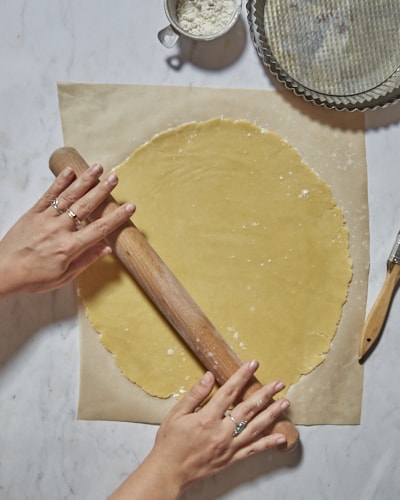
12. Let the chilled dough soften at room temp until it’s pliable but still cool. Roll out on a piece of baking paper, lightly dusted with flour, to the size/thickness you need.
What does shortcrust mean?
In baking, the term ‘short’ refers to a textural property of a baked good (usually things like scones, pastry and biscuits). It pretty much means that something has a crumbly texture…in a good way! Something which is ‘short’ should not be chewy or soggy – it’ll usually be quite dry and slightly crisp/crunchy in texture which melts in the mouth, falling apart easily when pressure is applied.
Ingredients for shortcrust pastry – explained
- Pastry Flour or Plain Flour – these types of flour have a lower gluten content than something like bread flour. A lower gluten content will help produce a more tender, crumbly pastry with a ‘short’ texture.
- Butter – the cold butter is rubbed into the flour, coating the flour particles which blocks them from absorbing too much water. When flour absorbs water, it allows the gluten proteins in the flour to start forming bonds between each other, too many of which can lead to tough pastry.
- Salt – this enhances the buttery flavour of the dough
- Egg (optional) – the fat of the egg yolk enriches the pastry whilst the egg white gives it structure (making it easier to work with). They’re both also wet so help to bind the dry ingredients together.
- Cold water – adding a small amount of water to the pastry dough gets the flour particles to stick together, making a cohesive dough without producing too many bonds between the gluten. If you’re adding whole egg, you may not need to add water.
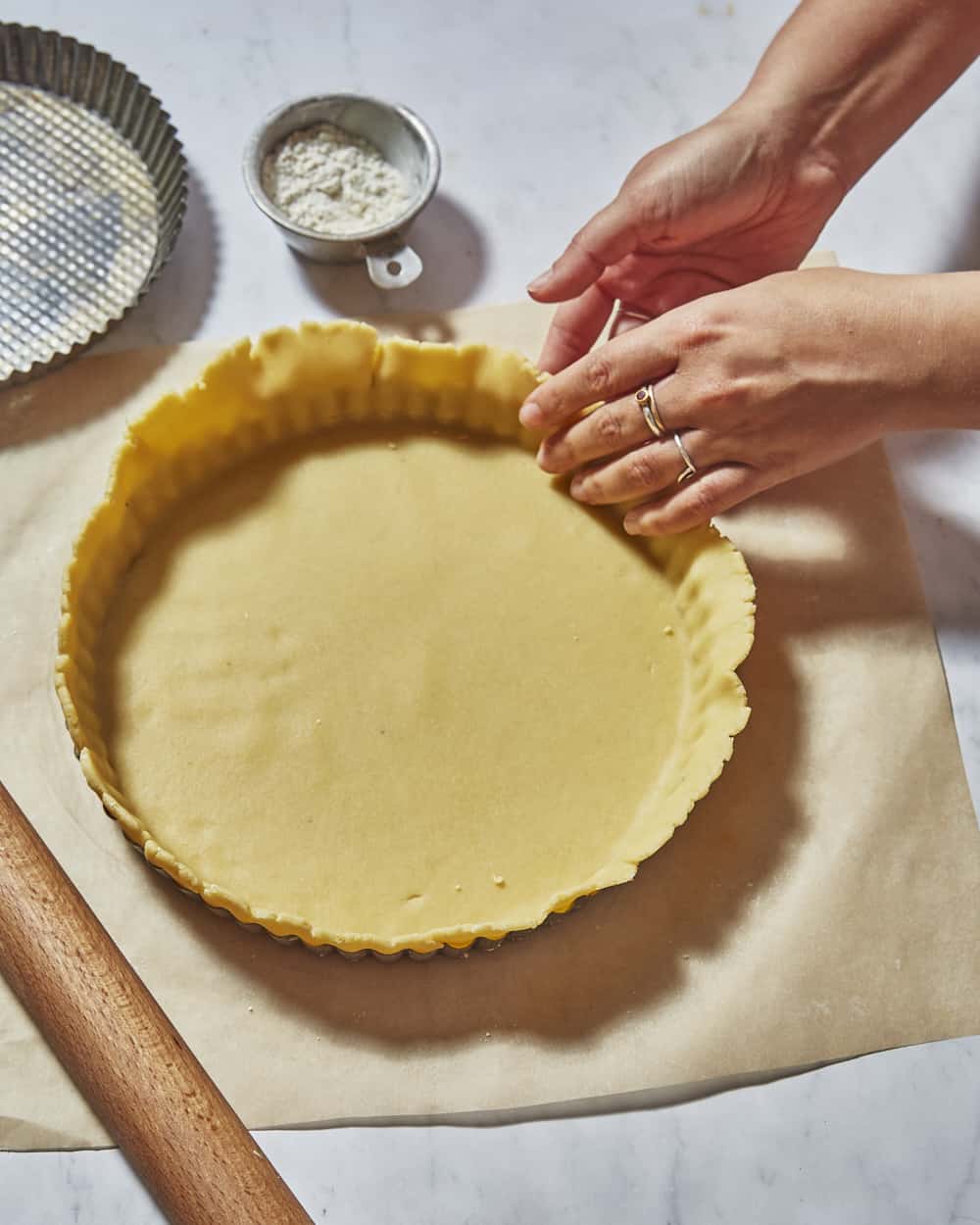
Using up leftover egg whites
As this recipe uses an optional egg yolk, you may find yourself with a single egg white knocking about. Here are some ideas for using it up:
- If you’re planning to make something like a quiche, go ahead and chuck that egg white into the filling mixture.
- You can lightly beat the egg white with a small pinch of salt until frothy (the salt helps to ‘loosen’ the egg white a bit). Then use this for brushing onto the top of a pie, either to give it a shiny appearance or to adhere seeds/toppings to your pastry.
- You can make a barrier against soggy fillings by using egg white. Blind bake your tart casing then remove from the oven, brush with egg white, and place back into the oven for 1-2 minutes before you add the filling and bake for the last time. The layer of egg white should help to prevent some of the moisture from the filling from making the pastry soggy. No soggy bottoms here!
- Use it in a cocktail! A gin sour (or whisky sour) is a great way to use up a single egg white, adding a frothy top to your shaken cocktail.
- I like using an egg white beaten with a bit of cinnamon, vanilla and a few tablespoons of milk to make a batter for French toast. You just dip stale bread into the mixture, turning to coat, then fry in a bit of butter or oil until golden on both sides. Perfect with a bit of maple syrup and butter for breakfast.
Mary Berry vs Delia Smith vs James Martin
The way I was taught to make shortcrust pastry was a 2:1 ratio of flour to butter (i.e. if you have 200g flour, you use 100g butter). This is the same ratio that James Martin uses, although he includes a whole egg in his pastry to help bind it together.
Mary Berry increases the proportion of butter slightly for hers, using 225g flour and 125g butter (a 1.8:1 ratio of flour to butter). Like Martin, she also uses a whole egg with some water to bind.
Delia Smith is an outlier in that she uses a combination of lard and butter in her pastry – I’ll get into the differences between lard and butter later on. Delia also goes the opposite way to Mary, reducing the proportion of fat in her recipe (25g lard, 25g butter, 110g flour) at 2.2:1 ratio of flour to butter. She uses no egg, only water, to bind her pastry.
Liquids in shortcrust pastry – egg yolk vs whole egg vs water
As you can see in the section above, popular recipes for shortcrust pastry can vary quite a bit. One of the main ways is by the ‘wet’ component which helps to bind the dry ingredients together.
Both Mary Berry and James Martin like to use a whole egg in their pastry. This is nice as you use up the whole egg and you end up with a pastry which is a bit more forgiving. This is because whilst the fatty egg yolk brings richness, the egg white provides structure.
If you want a rich, crumbly pastry, use just the egg yolk – the yolk is fatty and, when it is heated, coagulates to have a crumbly texture. This helps to give the pastry a light, short texture and a richer flavour.
When you include the egg white as well, this can make for a sturdier pastry but can end up making it less ‘short’ in texture. This is because the egg white has no fat content yet is high in protein and, when the protein coagulates during cooking, forms an elastic texture.
Some recipes, like Delia’s or BBC GoodFood, use just water to bind their pastry. If you’re allergic to eggs (or if you don’t have any eggs), this is a great option as it’s simple enough to get some cold water ready. However, I feel this does end up creating a less crumbly, slightly denser texture to the pastry as you’re not getting the added benefit of the fat from the egg yolk. Overall, it’s not going to make your pastry terrible if you just use water to bind but for the lightest texture I think including an egg yolk is the way to go.
Different Fats in Shortcrust Pastry
The most common fat to use in shortcrust pastry is unsalted butter, however some recipes replace some of the butter with other solid fats such as lard or vegetable shortening.
Using a solid fat is best as it’s malleable at room temperature so it easily combines with the flour, making the pastry form into a cohesive dough, without requiring the addition of too much water. This malleability of the fat also allows the pastry to be easily rolled out into thin sheets which retain their shape, as long as it doesn’t get too hot!
The fact that the fat is solid at room temperature also means that, when mixed with the flour, it’ll form chunks or films which will block the flour particles from absorbing too much water (see section below for more detail). On the other hand, liquid oils form dispersed, small droplets throughout the mixture which are far less effective at forming this waterproof barrier.
Replacing some of the butter with lard or vegetable shortening tends to produce a flakier, shorter pastry. This is because these ingredients have a higher melting point and contain less water than butter. This combinations means that they do a better job at protecting the flour from absorbing water, inhibiting gluten formation and thus producing a more tender texture. However, these fats tend to have a very plain flavour (unless you’re using un-refined lard) or a flavour which may be undesirable. A solution is to use them in combination with butter which has a rich flavour. I prefer to just use straight up butter as I tend to not buy lard nor shortening so using only butter is just easier for me.
Gluten development in shortcrust pastry
First, some background info. Gluten is a group of proteins found in flour. When introduced to water and then mixed/kneaded, the gluten proteins form bonds between each other and bond together into lattice network. This is what gives ‘strength’ to doughs (i.e. stops them from falling apart), allowing them to be stretched and shaped. It also can trap air bubbles and stretch, which is why things like bread doughs rise.
In pastry making, we’re generally only trying to VERY minimally develop the gluten network. Too much of this gluten network development and the pastry will be tough (too many bonds!). Too little development and the pastry will be incredibly crumbly and difficult to work with, although this usually isn’t an issue!
In order to limit gluten development in pastry making, we do a few things….
We rub butter into the flour first. This coats the flour particles with a thin layer fat, forming a barrier around them. Since water can’t travel through this layer of fat, it stops the flour from absorbing too much water when we add the wet ingredients. As the gluten network is only formed under absorption of water by flour, the fat inhibits the formation of the gluten network as we mix the pastry dough together.
Another part of limiting gluten development in pastry making is to mix the dough as little as possible. As gluten network development relies upon the input of ENERGY (i.e. mixing/kneading), we can limit mixing to prevent an over-developed network.
We do need *some* gluten development in the dough so that it’ll hold together, otherwise we wouldn’t be able to roll the pastry out without it falling apart. This is partly why there is a small proportion of liquid (usually eggs and/or water) added to the dough. It is also why we mix the dough only until it just comes together which helps to limit gluten development to only what is necessary to keep the pastry holding together.
Shortcrust Pastry FAQs
What is shortcrust pastry good for?
This simple, crumbly pastry is used for many different dishes, especially savoury recipes. It can be used for Cornish pasties, sausage rolls, quiche, vegetable tarts/pies or for the top of meat pies.
If you take a basic shortcrust pastry and include sugar, it can now be used for desserts! It’s best for fruited tarts, frangipane tarts and custard tarts.
Is shortcrust pastry vegetarian?
In many cases, yes it is vegetarian as the main fat used is usually butter, margarine or vegetable shortening. The instances when shortcrust pastry isn’t vegetarian are when lard, suet or other animal fats have been used to make the pastry in place of some/all of the butter.
Why is my shortcrust pastry tough?
As discussed above, gluten development in your pastry is somewhat of a balancing act. Too much gluten network development can lead to a tough, dense pastry. There are a few things which can cause this:
- Overmixing your pastry. This is probably one of the most common issues. As you mix/knead the pastry together, you’re helping the gluten strands to form bonds with each other. When making bread, this is essential as a large/strong gluten network traps air which makes dough rise. In pastry however, this will make the pastry tough. This is why you need to try to minimise your mixing as much as possible.
- Too much liquid in the dough. Excess water in the pastry will enhance the ability of the gluten to form a strong network. We don’t want this (we only want a little bit of gluten development!) so this is why it’s best to go slow when adding the liquid to your pastry so that you keep it to only *just* enough to help the dough stick together.
- Ingredients are too warm. Letting the butter get too warm will turn it from a malleable solid into a semi-liquid (or fully liquid) fat. Liquid fat is far less effective at coating the flour particles which means that water will be more readily absorbed by the flour. This will lead to more development of the gluten network.
Why is it important to work quickly when making shortcrust pastry?
One of the important parts of pastry making is the temperature. We want the butter to remain cool as it is firmer when at a lower temperature. Butter which is firmer forms a superior barrier around the flour particles than liquid fat, which prevents the flour absorbing too much liquid (as explained above, this would lead to more gluten development which is not good for shortcrust pastry).
As you let the ingredients sit at room temp, the butter becomes softer and softer making it less and less effective at preventing gluten development. The softer butter will also form a much softer pastry which will be sticky and harder to work with. This is why it’s best to be swift with your pastry making!
You can give yourself a bit more time by making sure all your other ingredients and equipment are cold too (especially handy if you’re in a hot climate). You can do this by weighing out your flour into a mixing bowl and placing this into the freezer for 10 minutes to chill it down. Make sure your wet ingredients are cold, too (NO WARM WATER!).
If it seems like your pastry ingredients are getting too warm as you’re mixing, just pop the bowl into the freezer for 5 minutes to chill it down before proceeding with the recipe.
Why is my pastry cracking when I roll it out?
Usually this is down to two things:
- The dough is too cold. As we have to rest the pastry in the fridge, the butter cools down and becomes firm. If the pastry isn’t allowed to soften after resting, attempting to roll it out will result in cracks around the edges.
- Not enough water/ moisture added to the pastry. Although we don’t want the pastry to be too wet, it is important to have adequate hydration in a dough for it to be malleable. The addition of water to the flour allows the flour particles to adhere to each other and means that the pastry can be formed into different shapes.
Why does shortcrust pastry shrink?
A bit of pastry shrinkage in the oven is inevitable – this is why lots of professional chefs will leave the excess pastry overhanging the edge of the tart tin, bake it like that, and THEN trim off the excess whilst the pastry is hot from the oven, using a sharp knife.
The reason the pastry shrinks is that the gluten proteins contract when baked which pulls the pastry in. If you find your pastry is shrinking a LOT, this is likely because you’ve overdeveloped the gluten and/or not allowed the gluten ample time to relax. A few causes of this are:
- Butter was too warm – doesn’t adequately coat flour particles with fat, allowing them to absorb too much water, developing gluten too much
- Too much water – excess water in the dough allows gluten proteins to form excess bonds, making dough too elastic.
- Overworking the pastry – develops the gluten network too much as mixing encourages bond formation between gluten proteins.
- Not letting pastry rest for long enough – the pastry has to rest to allow the gluten network to relax. Time is needed to allow some of the weaker bonds between the gluten proteins to break, making a more malleable texture.
- Dough was stretched when lining tart tin – it’s best to ease the pastry into the tart tin and let it fall into place, avoiding stretching it to get it into the bottom corners of the tin and instead try lifting the edges of the dough and gently coaxing it into the corners. Stretching the pastry = stretching the gluten strands which means it will retract when you bake it.
- Used flour with high protein content – higher protein flours (i.e. strong flour or bread flour) contain more gluten proteins. This means that the flour will form a stronger gluten network than plain flour so it’s best to stick to pastry flour or plain flour as these have a lower gluten content.
- Incorrect amount of butter and/or low-quality butter – we need adequate fat in pastry to prevent gluten formation in the dough. You want a butter/solid fat which has at least 75% fat in it (look at the nutrition label for the fat per 100g to figure this out). In the UK, most of our butter is around 80% fat but I know in the US, butter can have a higher water content. This is also why you shouldn’t use a low fat spread as they have a much higher water content. If you’re using margarine/vegan butter, please check the pack to make sure the fat content is 75% or more!
Is shortcrust pastry flaky?
Not really. The texture of shortcrust pastry is more often described as crumbly or melt-in-the-mouth. This is because we have limited the gluten development by rubbing the fat thoroughly into the flour. Therefore, there are no large pockets of butter to produce a ‘flaky’ texture, as you have with rough puff / flaky pastry.
How far in advance can I make shortcrust pastry / Does shortcrust pastry go off?
You can make shortcrust pastry up to 3 days in advance, as long as it is kept well-wrapped (in a ziplock bag or clingfilm) in the fridge.
As shortcrust pastry sits around, it will first oxidise and turn a grey colour after 1-2 days in the fridge – this is why it’s best to keep it wrapped in a ziplock bag with the air pushed out (or in clingfilm) as it limits oxygen reaching the dough. Oxidised pastry isn’t dangerous but will look off-colour when baked.
After a few days in the fridge the egg in the dough may start to go off, as may the butter, which is why you shouldn’t really keep it in the fridge for more than 3 days. If kept for longer than this, the pastry will start to smell bad and mould will start to grow on it.
If you want to store the shortcrust for longer than 3 days, wrap it in a ziplock bag with the air pushed out and then freeze it for up to 3 months.


Thanks so much for this detailed post! I always have issues with my pastry shrinking and now I know why
No problem! Glad it was helpful 🙂